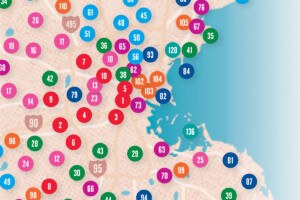Present at the Creation
The room’s desk was large and clutter-free. My mind, for perhaps the first time in weeks, also felt clutter-free. I got out the supplies for my drawing project—including special paper I had purchased in Arizona over the holidays—and carefully spread them out before me. Four wonderfully focused hours passed, and I began to wonder if maybe there was something to the blue-room phenomenon after all. As it turned out, that morning was one of my most productive in a very long time. I made progress on a Swarovski design case, finished a website for my new class, and nearly completed a website for d4d, an applied-research-and-design group I run that focuses on human behavior and innovation.
Creative as those achievements were, they had to do with work, and four hours in I realized that I had not yet made progress on my drawing project. Probably, I figured, because I still didn’t have the right paper. So I began Googling art-supply stores near Union Square. I found several, meticulously read all the reviews I could find online, and an hour later selected the finest of the nearby options.
I resolved to head out and get the proper paper…right after I made a few tweaks to the d4d website.
Hours passed. The shop had closed. I would go tomorrow.
When tomorrow arrived, I went to J.Crew to return a sweater, to Radio Shack to ask about fixing my cracked iPhone screen, and to a nail salon for a manicure, so I would look New York enough for the workweek ahead. I don’t remember what filled the rest of the afternoon, but by the time I was ready to go to the art store, it was closed again.
In truth, I never wound up buying the paper, and I never managed to recapture the blissful productivity of that first morning in my hotel room. That’s not to say the trip was a disappointment. I did work that was actually even more creative later that week, with colleagues, in a basement conference room with plain gray-white walls roughly indistinguishable from every other windowless hotel conference room in the world. But as the week wore on, my once bluetiful room filled up with papers, pamphlets, receipts, business cards, and Balance Bar wrappers. The jazz station, when I could find it, was so full of static that I no longer found it relaxing.
After I returned to Boston, I was keenly aware that I had still not drawn anything. But that, I realized, was simply because I needed better paper. So I walked to Bob Slate Stationer, in Harvard Square. I asked about handcrafted, cottonlike paper, and got escorted to a section of Italian-made cards.
I contemplated the cards, felt their edges, wondered about sizes and framing. I wondered what the hell I even planned to draw on them, looked at the pens, figured I already had nice enough pens at home, and walked out a half hour later with twenty 4-by-4-inch cards, only to pop over to Papyrus, around the corner, and repeat the process.
It was then that I understood something important: I was becoming obsessed. I kept buying stationery—over and over, as if the act of purchasing it somehow equated to the act of making art out of it. And that wasn’t the only problem I’d developed over the course of this project. There were all sorts of ways I kept cheating on my drawing goal: Online shopping for art supplies. Buying and selling used furniture. Researching creativity tips. Researching red flags in relationships. To name just a few.
In that moment, I began to reconsider my recent fixation with improving the physical space in my life. No longer content with renovating just my office, I’d moved on to redoing my home. Which is how I’d begun popping into the used-furniture shop around the corner so frequently that the owner, Eddie, and I were on a first-name basis. His shop was jumbled and stacked and crammed. You could hardly walk through to reach his counter in the back without asking him to move something out of the way. It felt a lot like someone had taken a snapshot of what this project had done to my mind and superimposed it on Eddie’s store.
In any case, I’d become convinced that replacing an ugly dresser would make my apartment nicer, that a nicer apartment would be more inspiring to work in, and that this inspiration would finally help me start drawing. So Eddie and I bargained over a dresser, and I brought it home. But it didn’t get me started drawing. Instead, it spawned a whole new project, yet another distraction from my goal. I soon found myself compelled to buy a trunk, a couch, and a side table, too, which meant I then had to sell the dresser I was replacing, and a side table, to Eddie. And after that I returned to the shop to look for a vanity to match my new dresser. But when Eddie brought it over, he accidentally broke it. He took it back. I tried to haggle for a velvety settee, but only if he would reupholster it in purple….
My friends warned me they were planning an intervention.
Not good. I was obviously going to have to find a way to control these urges. In Psychology Today, Scott Barry Kaufman reported on a 2010 study conducted at Leiden University, in the Netherlands. “Creative people,” he wrote, “are somehow really good at modulating their neurotransmitters at different points in the creative process.” In other words, they seem to be better than others at adjusting their level of focus to the task at hand. When exploring ideas, they can create periods of loose attention for themselves, and when implementing them, they can create periods of focused attention.
This sounded promising because, at this point, I was clearly unable to adjust my level of focus at all. I was getting obsessive about everything but drawing. The solution, apparently, lay in regulating my dopamine levels. I was willing to entertain the idea that all this ridiculous procrastinating meant something was wrong with my neurotransmitters, but I had no idea how I could fix that, and neither Kaufman nor the original Dutch study were very specific in that regard. So I Googled a few natural methods for moderating dopamine. Most of what I found linked dopamine to pleasurable activities. So I slept in, ate my favorite foods, took hot showers, drank beer, took hot showers while drinking beer (to test the combined effect), hung out with friends, made love, and chalked it all up to researching this article.
Suffice it to say that, as far as I’m aware, none of these things helped me with my drawings.
It shouldn’t be difficult to start drawing. Why was I failing?


